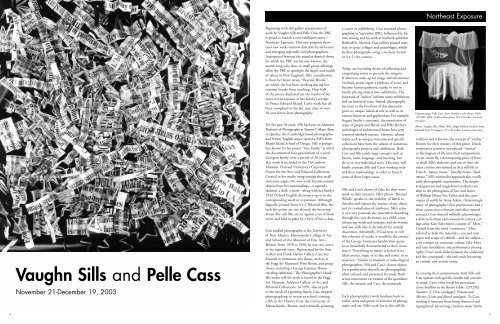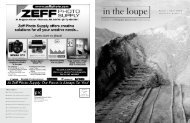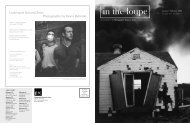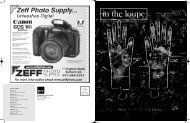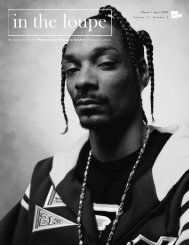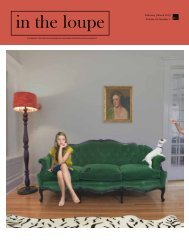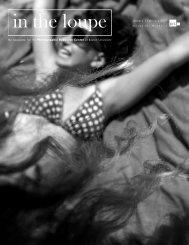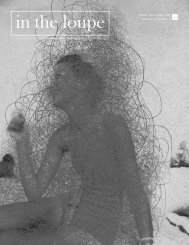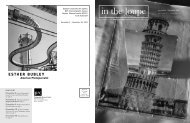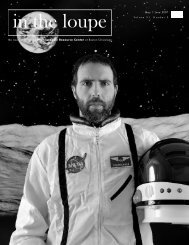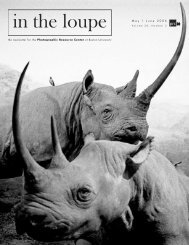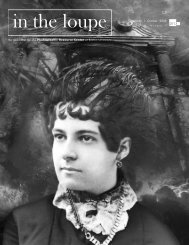November | December 2003 - Boston Photography Focus
November | December 2003 - Boston Photography Focus
November | December 2003 - Boston Photography Focus
You also want an ePaper? Increase the reach of your titles
YUMPU automatically turns print PDFs into web optimized ePapers that Google loves.
Northeast Exposure<br />
Vaughn Sills and Pelle Cass<br />
<strong>November</strong> 21-<strong>December</strong> 19, <strong>2003</strong><br />
Beginning with this gallery presentation of<br />
work by Vaughn Sills and Pelle Cass, the PRC<br />
is proud to launch a new exhibition series—<br />
Northeast Exposure. This new program showcases<br />
new works and new directions by mid-career<br />
and emerging regionally-tied photographers.<br />
Interspersed between the popular themed shows<br />
for which the PRC has become known, the<br />
month-long solo, duo, or small group offerings<br />
allow the PRC to spotlight the depth and wealth<br />
of talent in New England. Sill’s contribution<br />
is from her latest series, “Beyond Words,”<br />
on which she has been working during her<br />
summer breaks from teaching. Over half<br />
of the pieces displayed are the results of her<br />
most recent sojourn at her family’s cottage<br />
in Prince Edward Island. Cass’s work has all<br />
been completed in the last year, after an over<br />
10-year hiatus from photography.<br />
For the past 10 years, Sills has been an Assistant<br />
Professor of <strong>Photography</strong> at Simons College. Born<br />
in Quebec, this Cambridge-based photographer<br />
and former English major earned a MFA from<br />
Rhode Island School of Design. Sills is perhaps<br />
best known for her project “One Family,” in which<br />
she documented four generations of a rural<br />
Georgian family, over a period of 20 years.<br />
Her work is included in the DeCordova<br />
Museum, Harvard University’s Carpenter<br />
Center for the Arts, and Polaroid Collections.<br />
Created in her studio using settings that recall<br />
miniature stages, this new work features natural<br />
objects from her surroundings—a squirrel’s<br />
skeleton, a shell, a moth—along with her family’s<br />
1932 Oxford English dictionary open to the<br />
corresponding word or expression. Although<br />
digitally printed from 4 x 5 Polaroid film, the<br />
lush Iris prints are not altered; the hovering<br />
dream-like still lifes are set against a sea of black<br />
velvet and held in place by a bevy of bric-a-brac.<br />
Cass studied photography at the University<br />
of New Mexico, Minneapolis College of Art,<br />
and School of the Museum of Fine Arts,<br />
<strong>Boston</strong>. From 1978 to 1990, he was very active<br />
in the regional scene. Represented by the Stux<br />
Gallery and Frank Marino Gallery, Cass was<br />
featured in numerous solo shows, such as at<br />
the Fogg Art Museum’s Print Room, and group<br />
shows, including a George Eastman House<br />
traveling exhibition “The Photographer’s Hand.”<br />
His earlier still-life work is found in the Fogg<br />
Art Museum, Addison Gallery of Art, and<br />
Polaroid Collections. In 1991, due in part<br />
to the needs of a growing family, Cass stopped<br />
photographing to return to school, earning<br />
a BA in Art History from the University of<br />
Massachusetts, <strong>Boston</strong>, and eventually pursuing<br />
a career in publishing. Cass resumed photographing<br />
in September 2002. Influenced by his<br />
own writing and his work at textbook publisher<br />
Bedford/St. Martin’s, Cass utilizes printed materials<br />
to create collages and assemblages, which<br />
he then photographs using a medium format<br />
or 4 x 5 view camera.<br />
Today, an overriding theme of collecting and<br />
categorizing seems to pervade the zeitgeist.<br />
If almost to make up for image and information<br />
overload, artists ingest a plethora of icons, and<br />
become hunter-gatherers, neatly, or not so<br />
neatly, placing objects into cubbyholes. The<br />
buzzword of “archive” informs many exhibitions<br />
and art historical texts. Indeed, photography<br />
has been at the forefront of this discussion<br />
given its unique indexical role as well as its<br />
various functions and applications. For example,<br />
August Sander’s systematic documentation of<br />
types of people and Bernd and Hilla Becher’s<br />
anthologies of architectural forms have seen<br />
renewed scholarly interest. Likewise, related<br />
topics such as unique museums and specific<br />
collections have been the subject of numerous<br />
photography projects and exhibitions. Both<br />
Cass and Sills tackle large concepts such as<br />
beauty, order, language, and meaning, but<br />
do so in very individual ways. This essay will<br />
briefly contrast Sills and Cass’s working style<br />
and their methodology in order to broach<br />
some of these larger issues.<br />
Sills and Cass’s choice of titles for their series<br />
speak to their interests. Sills’s phrase “Beyond<br />
Words” speaks to the inability of labels to<br />
describe and capture the essence of any object<br />
and its constellation of attributes. Sills’s series<br />
is also very personal; she remembers thumbing<br />
through this very dictionary as a child, crossreferencing<br />
words and concepts, and the wonder<br />
and awe with which she beheld her natural<br />
discoveries. Admittedly, if Cass were to title<br />
this selection of works, it would be the essence<br />
of the George Santayana handwritten quote<br />
he so beautifully deconstructed to then reconstruct:<br />
“Everything in nature is lyrical in its<br />
ideal essence, tragic in its fate and comic in its<br />
existence.” Similar to museum or archeological<br />
photographers, Sills and Cass’s chosen objects<br />
(or reproductions thereof) are photographed,<br />
often isolated, and presented for study. Both<br />
artists concentrate on variants of the quotidian:<br />
Sills, the natural, and Cass, the manmade.<br />
Each photographer’s work hearkens back to<br />
earlier styles and genres in histories of photography<br />
and art. Sills’s work lies in the still life<br />
Opposite page: Pelle Cass, Every headline in the <strong>Boston</strong> Globe,<br />
12/12/02, <strong>2003</strong>, Gelatin silver print, 15 x 15 inches, Courtesy<br />
the artist.<br />
Above: Vaughn Sills, Moth, 2002, Singer Edition Iris print from<br />
Polaroid Type 55 negative, 25 x 20 inches, Courtesy the artist .<br />
tradition and references the concept of “vanitas.”<br />
Known for their mastery of this genre, Dutch<br />
renaissance painters introduced “vanitas”<br />
or fleetingness of life into their compositions<br />
via an errant fly, a decomposing piece of fruit,<br />
or skull. Sills’s skeletons and out of their element<br />
entities also remind us that still-life in<br />
French, “nature morte,” literally means “dead<br />
nature.” Sill’s minimalist approach also recalls<br />
early photographic experiments. The simple<br />
arrangements and single-hued aesthetics are<br />
akin to the photograms of lace and leaves<br />
of William Henry Fox Talbot and the cyanotypes<br />
of sealife by Anna Atkins. (Interestingly,<br />
many of photography’s first practitioners had a<br />
close connection to botany and other natural<br />
sciences.) Cass himself willfully acknowledges<br />
a debt to German early-twentieth century collage<br />
artist Kurt Schwitters’s concept of “Merz.”<br />
Coined from the word “commerce,” Merz<br />
referred to both the materials—cut and torn<br />
paper and scraps of rubbish—and the subject—<br />
a sly critique on consumer culture. Like Merz<br />
and later installation and performance photography,<br />
Cass’s work slides between the sculptural<br />
and the conceptual—the end result becoming<br />
an entirely new artistic entity.<br />
In creating their compositions, both Sills and<br />
Cass operate with specific intellectual conceits<br />
in mind. Cass’s titles reveal his procedure:<br />
Every headline in the <strong>Boston</strong> Globe, 12/12/02;<br />
Sweaters (J. Crew catalogue); Pictures and<br />
Mirrors (Crate and Barrel catalogue). To Cass,<br />
nothing is immune from being dissected and<br />
regurgitated: advertising circulars, water bottle<br />
8<br />
9


